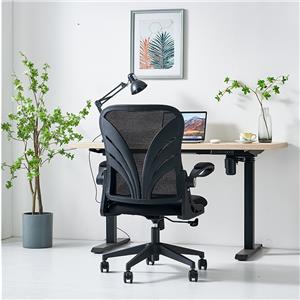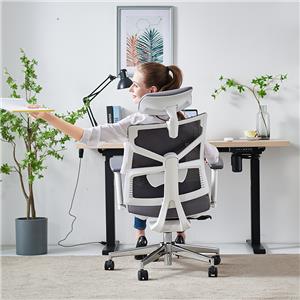A forgotten Bauhaus master: his chairs inspire the present
His name may not be widely known, but the furniture he designed continues to be popular.
He was Erich Dickmann (1896-1944), who had a background in architecture and painting, trained as a carpenter at the Bauhaus in Weimar, and was a protégé of Gropius. His tubular steel furniture is reminiscent of futuristic racing cars, the curves of his wicker chairs were imitated by later generations, and his cube-frame chairs were among the first mass-produced pieces of furniture.
At the time, Dickmann was almost as famous as Marcel Breuer, but today he is forgotten. The Paper has learned that the recently opened exhibition "Chair, Dickmann!" at Berlin's Museum of Decorative Arts provides an opportunity to look at Dickmann again.
Contemporary artist Margit’s collage creations of Dickman’s photographs. This is a tribute to Erich Dickmann and the first large-scale exhibition held in Germany in more than 30 years. The exhibition is made up of furniture, design drawings, and documentation from the period, as well as contemporary works based on Dickmann's design methods. Like Breuer, he experimented with various design forms and materials and developed a series of modular furniture. But compared to Breuer, his steel-tube furniture appears warmer and more approachable, which may have something to do with his original work with wood.
Dickmann and students sitting on wicker chairs in the garden, 1931 Dickmann and Bauhaus design Dickmann was born in 1896. In 1921, he came to the Bauhaus School in Weimar to become an apprentice in the furniture making workshop. Before that, he had studied architecture and painting. At the Bauhaus he first followed John Eaton (1888-1967, one of the most important faculty members of the Bauhaus) and was deeply influenced by the principal Gropius.
Although Dickmann was always looking for the possibility of manufacturing furniture in an industrial way, he did not abandon traditional wood and emphasized the natural characteristics of wood, especially fond of oak-bird's-eye maple, walnut-maple and walnut- A combination of elm wood.
Dickmann, "Wicker Chair", design manuscript, 1931. After completing his apprenticeship, Dickmann worked as a clerk in the Bauhaus furniture workshop and directed the design work. He helped process the chairs designed by Breuer and others, and they were very interested in furniture. They have the same opinion - pursuing designs with simple forms and suitable for industrial production.
In 1921, Dickmann was an apprentice at the Bauhaus in Weimar. After the Bauhaus moved to Dessau in 1925, Dickmann stayed at the successor institution, the Staatslochschule Weimar, headed by Otto Batning, and Become the leader of a furniture making workshop. During this period he established an example of furniture based on the requirements of modern residential architecture, developing furniture for kitchens, living rooms, bedrooms and children's rooms. These pieces of furniture can be combined and expanded in use in a variety of ways and, importantly, can be mass-produced at low cost.
In 1927, Dickmann designed a study for Otto Bamberg's villa. The design included sofas, tables and chairs, decorative fabrics, Bauhaus lighting, etc. The sliding door under the bookshelf can store a large amount of art. Dickmann also rose to prominence, incorporating into his designs what he had learned at the Bauhaus and previous studies of architectural painting. The furniture he designed entered the Weissenhof Estate project led by Ludwig Mies van der Rohe, and contemporary designers including Wilhelm Wagenfeld also chose to use and collect Dickmann's furniture . He also designed the interiors for a children's home in the open-air settlement near Neurupin. Dickmann developed a concept of psychological order and color for rooms and furniture. According to critic Walter Psage, Dickmann left behind a "colourful and formally cohesive furniture" that "beyond the conflicts and directions of the time."
In 1929, Dickmann gave a series of lectures on the development of modern furniture. Otto Batning applied for the title of professor, but the request was not approved due to university reconstruction and other reasons. In March 1930, the new dean of the Weimar State University fired all faculty members, including Dickmann. Otto Batning wrote a letter of recommendation to Dickmann before his retirement: "Both in art and in teaching. , Mr. Dickman proved himself as a teacher. A large number of talented young people were professionally trained in his teaching. At the same time, Mr. Dickman established schools and His own reputation.”
In 1930-1931, Dickmann came to the Halle School of Art and Design with Margarete Friedlander and Gerhard Max, and that summer opened his own furniture-making and interior design studio. He and his wife have published books describing their design work. Their work is called "geometric aesthetics", and he himself believes that "only when humanity is integrated into it can there be warmth and truth."
In 1931, however, Dickmann did not limit himself to purely geometric designs, and he also developed curvilinear models, which are pieces of bentwood, steel tube and wicker furniture that are on display at the exhibition.
Dickmann designed his first chair, made of wood and rushes, in 1923 while still a student at the Bauhaus. Although the design is simple, it is visible in sketches and photographs how the curvilinear forms would be incorporated into his later designs.
It was also this year that the Bauhaus was commissioned by the Thuringian government of Germany to hold a comprehensive design exhibition. One of the "Horn Houses" (Horn Exhibition Hall, a world cultural heritage) presented the concept of experimental residential architecture to the public. Dickman designed the interior design for his living room and dining room, which was Dickman's first independent execution. His designs were well received by the public for being "simple in furnishing and economical". In the "Weisenhof Manor" project in Stuttgart, Dickmann developed a combined system of living room, bedroom and dining room. Breuer particularly praised his bed design, which is composed only of modules and has a "clear and enduring beauty that fully satisfies aesthetic needs even without decoration."
The exhibition design of this exhibition at the exhibition site can also be regarded as a continuation of Dickman's design principles and ideals. The organizers used a sustainable architectural framework with a lightweight structure to insert the exhibition elements into each other, and the lamps specially developed for the exhibition formed a long line of light. , accompanying the audience through the exhibition hall. The typeface created by designer Eric Spikelman constitutes another clear and formal expression.
The 1931 exhibition is also accompanied by works by Dickmann's contemporaries, including Breuer and Mies van der Rohe, who both lived through both world wars, and together the display illustrates the diversity of furniture styles in 1930. In the "Living Like Dickman" section, contemporary artist Margit and designer Stephen Schulz demonstrate how Dickman's designs can be made sustainable, artistic, and beneficial improvements in the 21st century. They replicated Dickman's furniture and relocated it into a contemporary living environment.
The documentary exhibits in this exhibition from 1925 to 1935 mainly come from the "Dickmann Heritage" acquired by the German Art Library in 1970. The collection contains approximately 1,600 items, including Dickman's composition studies, furniture design drafts, interior watercolors, etc. Viewed in conjunction with furniture, these pieces allow one to experience the creative process – from initial, often abstract formal concepts, through creative and functional development, and finally as practical objects. At present, the "Dickmann Heritage" and the courses designed and compiled by Dickmann and his collaborators at the Bauhaus and Halle School of Art and Design have been digitally cataloged and are available on SMB-digital.
Through exhibitions and open documentation from 1931 to 1933, this almost forgotten Bauhaus master was once again noticed. He also added a new look to the image of Bauhaus design of that era. However, Dickmann died in Berlin in November 1944 at the age of 48. In fact, he left school as early as 1933 and eked out a living by working as a clerk and consultant in a design company. However, he had a profound influence on design teaching, and his design principles continue to this day.




